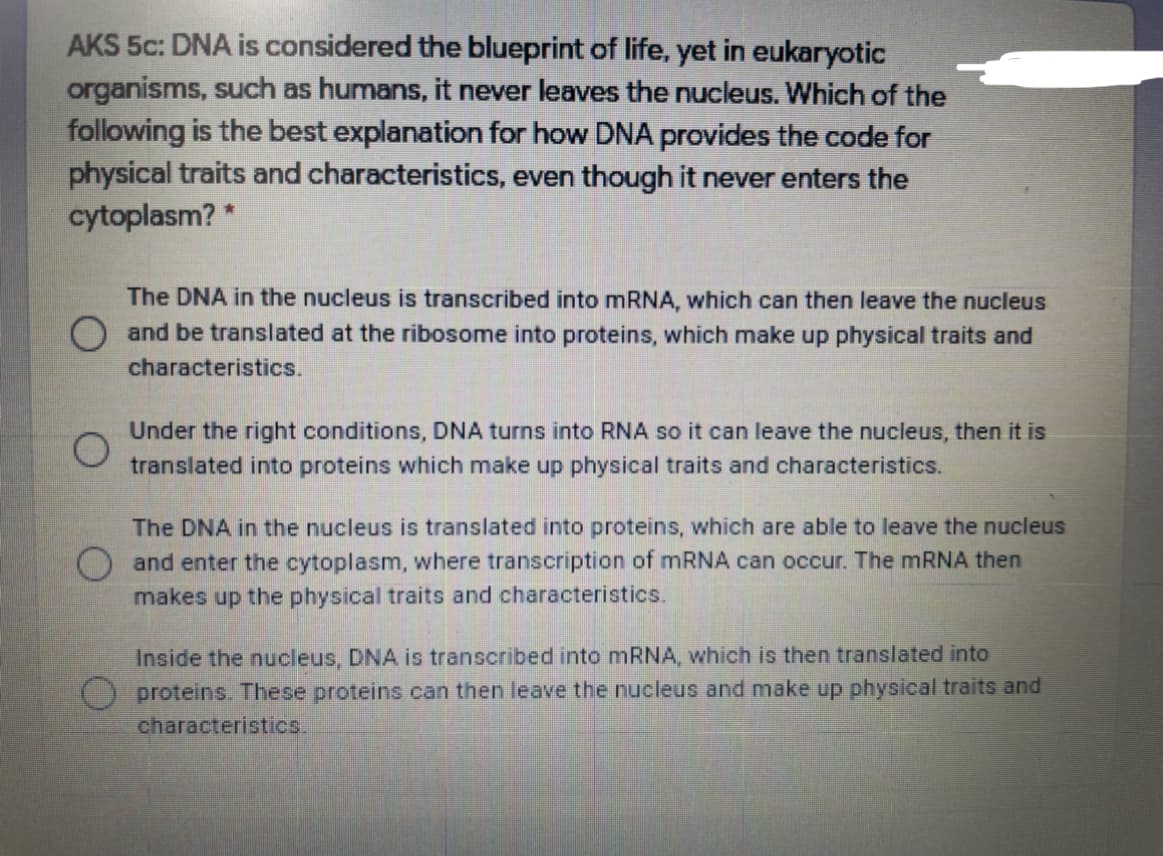AKS 5c: DNA is considered the blueprint of life, yet in eukaryotic organisms, such as humans, it never leaves the nucleus. Which of the following is the best explanation for how DNA provides the code for physical traits and characteristics, even though it never enters the cytoplasm? * The DNA in the nucleus is transcribed into MRNA, which can then leave the nucleus O and be translated at the ribosome into proteins, which make up physical traits and characteristics. Under the right conditions, DNA turns into RNA so it can leave the nucleus, then it is translated into proteins which make up physical traits and characteristics. The DNA in the nucleus is translated into proteins, which are able to leave the nucleus O and enter the cytoplasm, where transcription of MRNA can occur. The MRNA then makes up the physical traits and characteristics. Inside the nucleus, DNA is transcribed into mRNA, which is then translated into O proteins. These proteins can then leave the nucleus and make up physical traits and characteristics.
AKS 5c: DNA is considered the blueprint of life, yet in eukaryotic organisms, such as humans, it never leaves the nucleus. Which of the following is the best explanation for how DNA provides the code for physical traits and characteristics, even though it never enters the cytoplasm? * The DNA in the nucleus is transcribed into MRNA, which can then leave the nucleus O and be translated at the ribosome into proteins, which make up physical traits and characteristics. Under the right conditions, DNA turns into RNA so it can leave the nucleus, then it is translated into proteins which make up physical traits and characteristics. The DNA in the nucleus is translated into proteins, which are able to leave the nucleus O and enter the cytoplasm, where transcription of MRNA can occur. The MRNA then makes up the physical traits and characteristics. Inside the nucleus, DNA is transcribed into mRNA, which is then translated into O proteins. These proteins can then leave the nucleus and make up physical traits and characteristics.
Biology: The Dynamic Science (MindTap Course List)
4th Edition
ISBN:9781305389892
Author:Peter J. Russell, Paul E. Hertz, Beverly McMillan
Publisher:Peter J. Russell, Paul E. Hertz, Beverly McMillan
Chapter10: Cell Division And Mitosis
Section: Chapter Questions
Problem 3TYK: A major difference between hereditary information in eukaryotes and prokaryotes is: a. in...
Related questions
Question
I need help with this biology homework question. Thanks.

Transcribed Image Text:AKS 5c: DNA is considered the blueprint of life, yet in eukaryotic
organisms, such as humans, it never leaves the nucleus. Which of the
following is the best explanation for how DNA provides the code for
physical traits and characteristics, even though it never enters the
cytoplasm? *
The DNA in the nucleus is transcribed into MRNA, which can then leave the nucleus
O and be translated at the ribosome into proteins, which make up physical traits and
characteristics.
Under the right conditions, DNA turns into RNA so it can leave the nucleus, then it is
translated into proteins which make up physical traits and characteristics.
The DNA in the nucleus is translated into proteins, which are able to leave the nucleus
and enter the cytoplasm, where transcription of mRNA can occur. The MRNA then
makes up the physical traits and characteristics.
Inside the nucleus, DNA is transcribed into mRNA, which is then translated into
proteins. These proteins can then leave the nucleus and make up physical traits and
characteristics,
Expert Solution
Step 1
Introduction
Genome is the essential part of any organisms which is either composed of DNA or RNA. DNA is mostly found in the organisms. DNA is composed of nucleotides sequence which contains the transcriptionally active genes. Gene are the main component of the genome which controls all the cellular activities and other inherited morphological and physiological traits.
Genes controls the expression of the various trait by formation of respective proteins.
Trending now
This is a popular solution!
Step by step
Solved in 2 steps

Knowledge Booster
Learn more about
Need a deep-dive on the concept behind this application? Look no further. Learn more about this topic, biology and related others by exploring similar questions and additional content below.Recommended textbooks for you

Biology: The Dynamic Science (MindTap Course List)
Biology
ISBN:
9781305389892
Author:
Peter J. Russell, Paul E. Hertz, Beverly McMillan
Publisher:
Cengage Learning

Biology 2e
Biology
ISBN:
9781947172517
Author:
Matthew Douglas, Jung Choi, Mary Ann Clark
Publisher:
OpenStax

Biology: The Unity and Diversity of Life (MindTap…
Biology
ISBN:
9781337408332
Author:
Cecie Starr, Ralph Taggart, Christine Evers, Lisa Starr
Publisher:
Cengage Learning

Biology: The Dynamic Science (MindTap Course List)
Biology
ISBN:
9781305389892
Author:
Peter J. Russell, Paul E. Hertz, Beverly McMillan
Publisher:
Cengage Learning

Biology 2e
Biology
ISBN:
9781947172517
Author:
Matthew Douglas, Jung Choi, Mary Ann Clark
Publisher:
OpenStax

Biology: The Unity and Diversity of Life (MindTap…
Biology
ISBN:
9781337408332
Author:
Cecie Starr, Ralph Taggart, Christine Evers, Lisa Starr
Publisher:
Cengage Learning

Anatomy & Physiology
Biology
ISBN:
9781938168130
Author:
Kelly A. Young, James A. Wise, Peter DeSaix, Dean H. Kruse, Brandon Poe, Eddie Johnson, Jody E. Johnson, Oksana Korol, J. Gordon Betts, Mark Womble
Publisher:
OpenStax College

Biology (MindTap Course List)
Biology
ISBN:
9781337392938
Author:
Eldra Solomon, Charles Martin, Diana W. Martin, Linda R. Berg
Publisher:
Cengage Learning